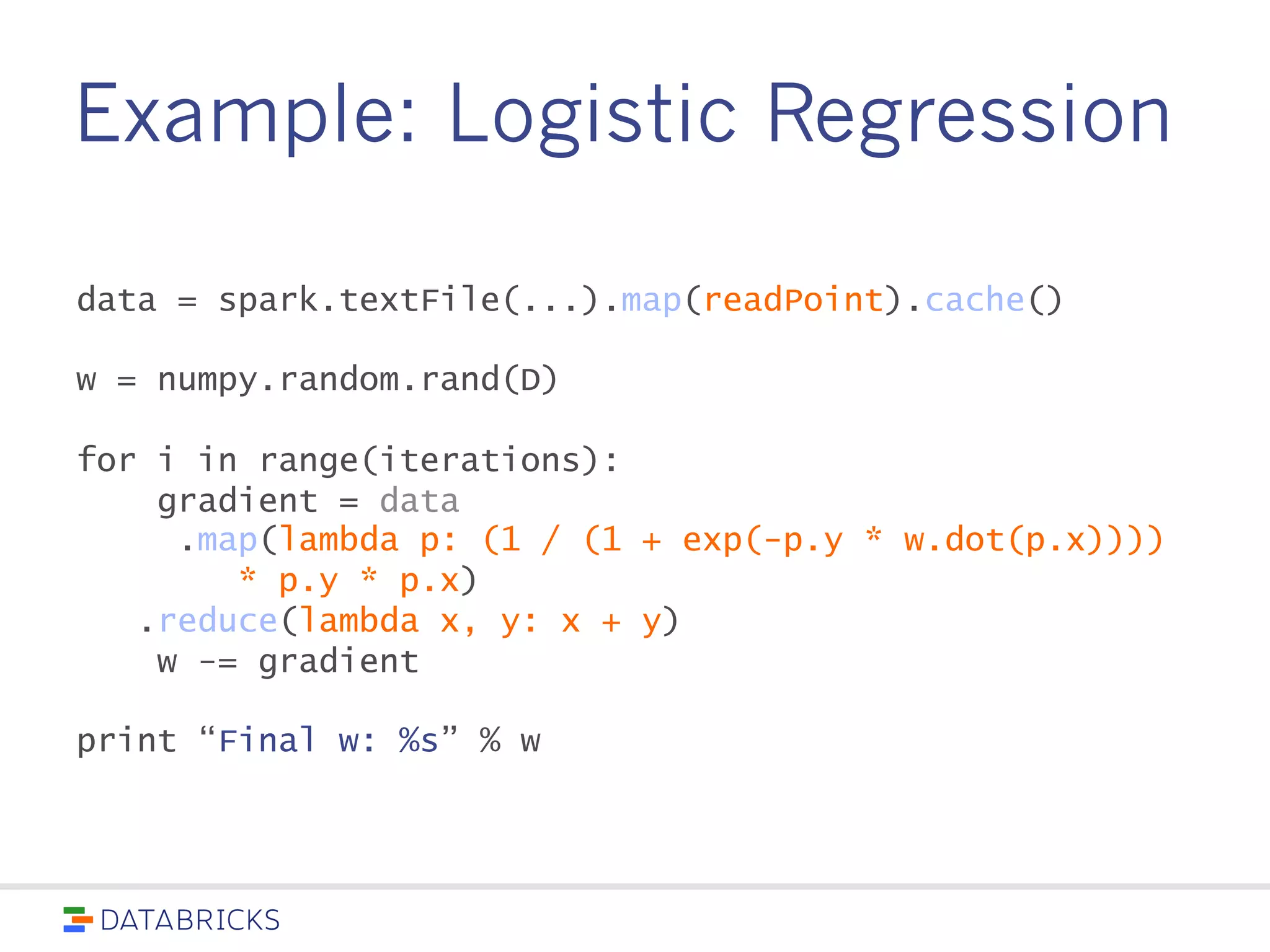MapR and Databricks have developed a top-ranked Hadoop distribution focusing on enterprise-grade features such as high availability, data protection, and security. This document highlights the capabilities of the MapR platform, including its integration with Apache Spark for real-time data processing, machine learning support, and the provision of a unified system for handling diverse data types and processing models. The collaboration with Databricks ensures comprehensive support for the entire Spark stack, enhancing performance and usability in big data environments.

















![Easy: Example – Word Count
Spark
public static class WordCountMapClass extends MapReduceBase
implements Mapper<LongWritable, Text, Text, IntWritable> {
private final static IntWritable one = new IntWritable(1);
private Text word = new Text();
public void map(LongWritable key, Text value,
OutputCollector<Text, IntWritable> output,
Reporter reporter) throws IOException {
String line = value.toString();
StringTokenizer itr = new StringTokenizer(line);
while (itr.hasMoreTokens()) {
word.set(itr.nextToken());
output.collect(word, one);
}
}
}
public static class WorkdCountReduce extends MapReduceBase
implements Reducer<Text, IntWritable, Text, IntWritable> {
public void reduce(Text key, Iterator<IntWritable> values,
OutputCollector<Text, IntWritable> output,
Reporter reporter) throws IOException {
int sum = 0;
while (values.hasNext()) {
sum += values.next().get();
}
output.collect(key, new IntWritable(sum));
}
}
Hadoop MapReduce
val spark = new SparkContext(master, appName, [sparkHome], [jars])
val file = spark.textFile("hdfs://...")
val counts = file.flatMap(line => line.split(" "))
.map(word => (word, 1))
.reduceByKey(_ + _)
counts.saveAsTextFile("hdfs://...")](https://image.slidesharecdn.com/maprdatabrickswebinar4x3-140430131948-phpapp02/75/Let-Spark-Fly-Advantages-and-Use-Cases-for-Spark-on-Hadoop-18-2048.jpg)
![Easy: Example – Word Count
Spark
public static class WordCountMapClass extends MapReduceBase
implements Mapper<LongWritable, Text, Text, IntWritable> {
private final static IntWritable one = new IntWritable(1);
private Text word = new Text();
public void map(LongWritable key, Text value,
OutputCollector<Text, IntWritable> output,
Reporter reporter) throws IOException {
String line = value.toString();
StringTokenizer itr = new StringTokenizer(line);
while (itr.hasMoreTokens()) {
word.set(itr.nextToken());
output.collect(word, one);
}
}
}
public static class WorkdCountReduce extends MapReduceBase
implements Reducer<Text, IntWritable, Text, IntWritable> {
public void reduce(Text key, Iterator<IntWritable> values,
OutputCollector<Text, IntWritable> output,
Reporter reporter) throws IOException {
int sum = 0;
while (values.hasNext()) {
sum += values.next().get();
}
output.collect(key, new IntWritable(sum));
}
}
Hadoop MapReduce
val spark = new SparkContext(master, appName, [sparkHome], [jars])
val file = spark.textFile("hdfs://...")
val counts = file.flatMap(line => line.split(" "))
.map(word => (word, 1))
.reduceByKey(_ + _)
counts.saveAsTextFile("hdfs://...")](https://image.slidesharecdn.com/maprdatabrickswebinar4x3-140430131948-phpapp02/75/Let-Spark-Fly-Advantages-and-Use-Cases-for-Spark-on-Hadoop-19-2048.jpg)






![Easy: Fault Recovery
RDDs track lineage information that can be used to
efficiently recompute lost data
msgs = textFile.filter(lambda s: s.startsWith(“ERROR”))
.map(lambda s: s.split(“t”)[2])
HDFS File Filtered RDD Mapped RDD
filter
(func = startsWith(…))
map
(func = split(...))](https://image.slidesharecdn.com/maprdatabrickswebinar4x3-140430131948-phpapp02/75/Let-Spark-Fly-Advantages-and-Use-Cases-for-Spark-on-Hadoop-26-2048.jpg)




, row(2), row(3))
LabeledPoint(row(0), features)
}
val model = new
LogisticRegressionWithSGD().run(trainingData)](https://image.slidesharecdn.com/maprdatabrickswebinar4x3-140430131948-phpapp02/75/Let-Spark-Fly-Advantages-and-Use-Cases-for-Spark-on-Hadoop-31-2048.jpg)





![MLlib – Machine Learning library
Logis] c*Regression,*Linear*SVM*(+L1,*L2),*Decision*
Trees,*Naive*Bayes"
Linear*Regression*(+Lasso,*Ridge)*
Alterna] ng*Least*Squares*
KZMeans,*SVD*
SGD,*Parallel*Gradient*
Scala,*Java,*PySpark*(0.9)
MLlib
Classifica. on:"
Regression:"
Collabora. ve"Filtering:"
Clustering"/"Explora. on:"
Op. miza. on"Primi. ves:"
Interopera. lity:"](https://image.slidesharecdn.com/maprdatabrickswebinar4x3-140430131948-phpapp02/75/Let-Spark-Fly-Advantages-and-Use-Cases-for-Spark-on-Hadoop-37-2048.jpg)









